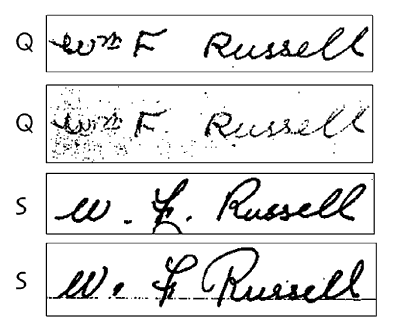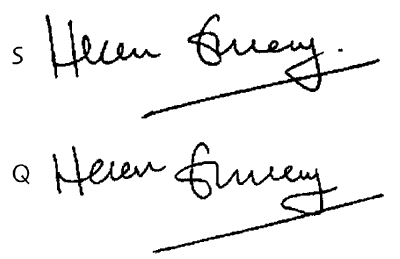
Handwriting Identification: Practice and TheoryThere is a belief that there are perceptible characteristics in the handwritten trace that can be used to identify the author of that handwriting. This is an extremely widespread belief: signatures, for instance, are used commonly and casually to authenticate all kinds of transactions, and this authentication quite often guarantees a great deal of money. There is also a belief that there are people called handwriting experts who can recognise these characteristics and, with reasonable reliability (often, in fact, beyond reasonable doubt), make identifications on the basis of that recognition. I think I can reasonably claim to be one of those people, since my evidence has been accepted in court doing just that, speaking with the privileged voice of an expert witness, many many times over nearly thirty years, and I have worked on some thousands of forensic handwriting cases. So, speaking if I may with that voice, I would say that in my opinion that skill exists, that it is learnable by those who have a reasonable potential competence at it, and that it is also rule-bound, though a number of the rules are not fully understood, and dependent on a body of solid information, though much of that information has not been fully explored or rendered explicit. What I will do in this brief paper is give just two examples of the practice of handwriting identification, and attempt to sketch some of the principles behind this practice. Here is my first case. Mr Russell was denying that he signed the document, and someone else was saying that he did. At the top is the questioned signature, Q; underneath it is the same signature photographed under ultra violet light. 
One can just see that there are some faint pencil markings around the initials - W.F.R - of the signature, which seem roughly to repeat the form of the initials. Now, it is known that rather incompetent forgers might make a trial attempt in pencil, trace over it in ink, then erase the pencil (usually leaving behind easily realisable evidence of what they have been up to). Is that what happened here? I was shown a report by another handwriting expert that says it was. Here is another oddity. S are just two of the sample signatures that I used. If you compare them with the questioned signature, you can see that the 'ussell' part of the Q signature resembles rather exactly the equivalent bit of the sample signatures; while the initials, WFR, do not resemble the sample at all. Why is this? Let me inject a little theory at this point. Handwriting experts can be said to work on three levels of analysis of handwriting: letter formation, detail of the letter, and line quality. Letter formation is the basic way in which the letter is formed: so, the letter formation of the /F/ differs between the questioned and sample signatures in the case of Mr Russell. Detail of the letter deals with the differences or similarities between writings whose letter formation is more or less the same: so, for instance, the detail of the 'ussell' is extremely similar in the case of Russell Q and S, and the detail of the /W/ is different, though in that letter the letter formation is more or less the same. Line quality is the most delicate of the three, and refers to the way the writer's skill, competence, and other factors are shown in the written trace of the handwriting movement. It is an indication of speed and fluency: the better the line quality, the more skilled, or at least fast, the movement of the pen. Poor line quality can indicate forgery. In forensic handwriting identification, line quality is extremely important. And in the Russell case, the line quality of the capitals in Q is poor, but that of the rest of the signature is reasonably good, and matches well that of the S signatures. Therefore, in the case of Mr Russell, either we have a very skilled 'ussell' forger who was unfortunately bad at doing capital letters, which seems unlikely; or else the 'ussell' is genuine, and the capitals are forged, which also does not seem very likely. However, that second possibility is in fact what happened. Lawyers sometimes have the habit of writing initials in pencil where they intend the signator to sign. Mr Russell took this as an instruction as to how to write, and obediently traced the initials, effectively forging part of his own name, and then wrote his normal fluent 'ussell' after that. Here are some principles we can deduce from this rather odd case. One is, handwriting is produced by human beings. It leaves a written trace, and this is fairly stable and predictable once written; but it is the trace of a human behaviour, and people are unpredictable and peculiar. In particular, handwriting is subject to conscious intention, and is modifiable: at that level, it is not stable, and hard to predict. Second, in general, letter formation is not a reliable indicator of identity. Letter formation is very much under the control of the writer. For example, most competent writers have at their disposal a number of fairly distinct alphabets: lower case cursive, upper case cursive, block capitals, and that style which most people learn before they learn the joined-up writing, which is called print script. So, as a general rule, handwriting identification is not interested in gross areas of similarity or difference, but in those areas of fine detail that are less likely to be in the writer's conscious control: in other words, we work principally at the level of letter detail and line quality. Here is a signature, S; followed by a forgery of that signature, Q.  The forgery is quite good, both in line quality and letter formation, and at first sight looks very convincing. But look at it closely. Firstly, the laudable concentration on line quality has led to a gross error, in that an extra minim has been inserted. Then close examinations reveals that the line quality also lets it down. The capital /E/ of the surname is slightly less assured, with a tendency for curves to turn into straight lines and corners, which is very characteristic of forgery. And, in the case of the lower loop of the final /y/, the reverse has occurred: a curve in place of an angle and straight line. Then look at the end of that stroke: in the genuine signature the pressure of the pen reduces gradually, while in Q the line ends abruptly, no doubt with relief; a failure of concentration at the end of the job. Forgery is really very very difficult, and handwriting identification itself is not easy; but it can be done, and, I would maintain, it can be theorised, taught, and tested. Tom Davis, University of Birmingham Home | What's New | Events | Images | Links |
| Created on |